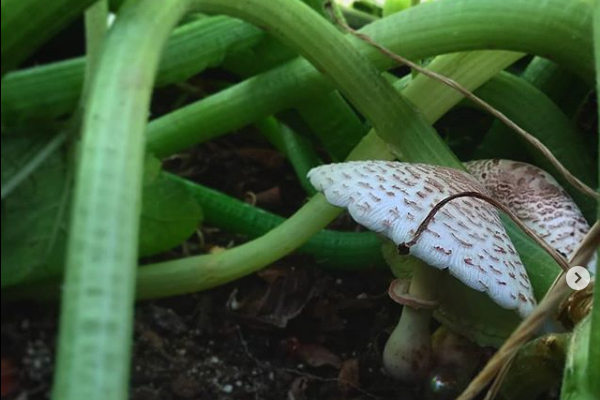Cultivating Oyster Mushrooms and other Fungi in Gardens

Edible mushrooms are ubiquitous and, in many scenarios, relatively easy to cultivate following the initial effort. Many species consume a variety of substrates, including mulch and compost, which makes them well-suited to gardening conditions. Overall, there is little focus on incorporating mushrooms into gardening practices though they can provide a secondary crop, break up complex molecules and fertilize plants, and successful cultivation of local varieties can provide a perennial harvest.
One of the simplest examples of cultivated mushrooms is Pleurotus ostreatus, the oyster mushroom. This cosmopolitan species is a white rot fungus traditionally found on dead trees and it can leverage its oxidative enzymatic capacity to essentially monopolize a log’s real estate or sterilized bags of substrate – like grain or corn, etc. Spores are readily obtainable online, but one can harvest spores from some of the local specimens. In fact, I’ve harvested and lightly cooked some delicious oysters from the bike path that connects Rightmire to North Star Road. Once obtained, the white spores can be plated and isolated on agar. Then, a pressure sterilized spawn bag of edible, moist (but not overly saturated) substrate is inoculated with the purified culture. As the mycelium overtakes the substrate, baby fruiting bodies emerge and holes are cut in the spawn bag to allow the mushrooms to break through. It’s important to spray water at this stage to keep humidity high.
These mushrooms are edible and one can also take a plug of the mycelium-infested grain and insert it into a hole drilled into newly harvested logs. Following a 12-24 hr soaking in water, these logs can be set outside and will be consumed by the oyster for a perennial harvest. If given opportunity, they may even emerge in different seasons and inoculate nearby logs as well. It’s therefore important to use a local variety for outdoor cultivation to prevent invasives. One can imagine it may be possible to set up a rotating system whereby each year new logs are cut and plugged with mycelium from other logs.
Oysters are perhaps the simplest example of mushroom cultivation, however, local varieties of myriad species can be harvested and inoculated into gardens. Pictured to the right, growing alongside my zucchini, is Leucoagaricus americanus. This is an edible variety similar to the parasol mushroom, which I recently identified in my compost. Considering I add a healthy layer of compost to my raised bed each year, I assume this edible species will continue to reappear. Shiitake is a popular edible as well that can be cultivated readily at home.
Simply put, if one can emulate the natural conditions and substrate of a local variety, cultivating it for perennial harvest is often simple and can be less strenuous than maintaining plants. Cultivation can be difficult with obligate mycorrhizal symbionts or other ecologies, but white rot fungi in general are some of the most delicious varieties of mushrooms and their shotgun approach to metabolizing substrates makes them amenable to a variety of growth conditions.
Written by TPS Fellow Zach Konkel
